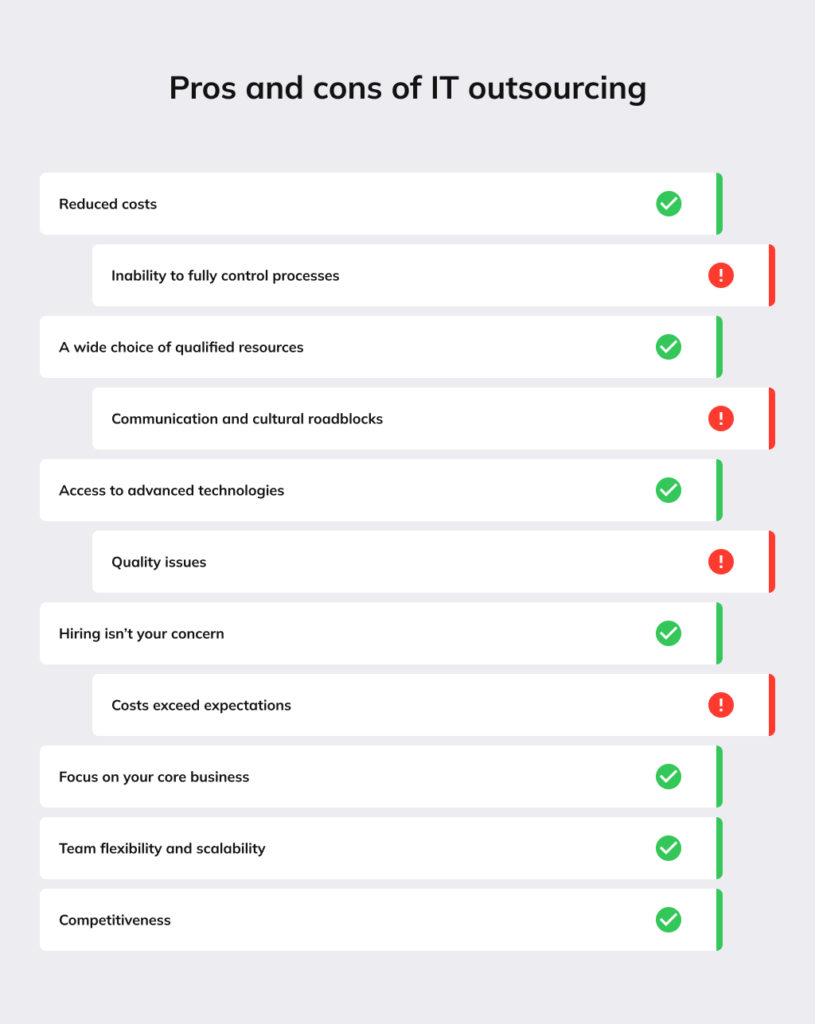Your message has been sent.
We’ll process your request and contact you back as soon as possible.
The form has been successfully submitted.
Please find further information in your mailbox.


It may seem intimidating to start outsourcing software development if you haven’t done it before. That’s perfectly understandable! It is a big decision to entrust your IT projects to an external IT company, regardless of size or capacity, especially when your business’s success depends on it.
In a McKinsey survey, 87% of respondents reported they either have gaps in their IT teams now or expect them shortly due to recruitment bottlenecks.
This statement is supported by many other sources, and the global IT talent shortage has grown significantly in recent years. The Manpower Group reports a shortage of IT talent in 54% of companies.
IT outsourcing is a business model in which outsourced services are provided by third-party companies to help businesses improve their efficiency and performance. Outsourcing can have a significant impact on businesses because it can provide them with better value for their money, increased flexibility, and increased worker productivity.
The benefits of IT outsourcing can be significant, and there are a variety of reasons why businesses might choose to outsource certain tasks or services.
Let’s clarify the difference between offshoring and outsourcing.
Offshoring is just one type of outsourcing. Overall, there are three types of it outsourcing:



Lack of expertise is the main hindrance to effective software development.
By outsourcing your software development projects, you save on hiring and get the opportunity to optimize and improve your business operations.
The fierce competition in the marketplace has led many enterprises to restructure and downsize their workforces to save money. Outsourcing helps businesses reduce costs by about 15% on average but this number can reach 60% in some cases. It is primarily for financial reasons that management decides to opt for information technology outsourcing.
Outsourcing providers can reduce your business’s expenses because they
Whenever you hire someone, you get only the skills this person possesses, and despite the person’s great skills, sometimes they lack the expertise needed for a specific project.
Outsourcing allows companies to access a variety of experienced and skilled human resources. Besides, it increases business productivity since outsourcing service providers can coordinate human resources and use them to their full potential. Moreover, labor efficiency increases if human resources are used effectively.
In today’s technology-driven world, most companies must adopt a broad range of advanced technologies to avoid being left behind by competitors. Even so, investing in technology innovation isn’t easy, as it always requires a significant amount of investment. The more technology changes, the more difficult it becomes to absorb them. As a result of outsourcing, businesses will be able to solve all their problems. They will still be able to innovate and develop new and modern methods without spending too much money.
If you create an in-house IT department you’ll need adequate office space and equipment, such as desks and computers, as well as insurance and sick and holiday pay. Outsourcing developers requires no hiring – just signing a contract. By doing so, you can save on employee benefits, training, and employment costs. You have partial responsibility for the employed developers who work in your team, and they are not on your payroll.
What is more, with outsourced teams, the hiring and research work has already been done. You can hire an outsourced team at the same time it takes to hire a single developer in your own company. Consider the potential savings in time and money that this may bring you.
Outsourcing enables companies to focus on broader issues and let an outside firm handle operational details. One of the most compelling reasons to outsource is to relieve management of low-priority issues that consume a great deal of their time and effort.
In some cases, outsourcing is done to strengthen weak areas of the organization or to assist with larger projects. This allows on-site staff to concentrate on their specialties and prioritize goals. A company that outsources IT, for instance, can prioritize larger tasks such as cybersecurity monitoring, network upgrades, or infrastructure installation.
Concentrating on your core business will certainly help you achieve a better result, since you won’t be distracted and won’t lose sight of your original idea. A key benefit of using outsourced workers is that they help to protect regular employees from swings in demand and allow the organization to strengthen its bonds with its own staff.
One of the best things about outsourcing software development is that you can get on-demand services. In terms of time and money, scaling your project as needed has huge benefits.
By outsourcing IT, you can delegate tasks to several highly qualified experts to improve turnaround time. Greater flexibility in staffing allows you to scale IT resources to meet project requirements and seasonal changes.
Outsourcing can be a great way to scale up your development team. By outsourcing certain tasks you can reduce the amount of work you need to do on your own, optimize resource use, and reduce the risk of project failure. This allows for a higher degree of flexibility, which can save you time and money.
In organizations lacking proactive IT leadership, outsourcing providers can enhance their efficiency, agility, and competitiveness. In addition to strengthening your competitive position and protecting you from cyber threats, IT outsourcing companies assist you in embracing new technologies, building innovative processes, and adopting a more efficient business model. So, the use of outsourcing is becoming increasingly common among organizations to reposition themselves, reconfigure how they do business, and transform the competitive landscape.

Outsourcing can be a great solution for businesses that need to keep up with the latest technology trends, but it’s important to consider the potential drawbacks before making any decisions. Here are four key things to keep in mind when deciding whether to outsource IT services.
The notion of handing over large parts of your organization’s infrastructure and processes to another outsourcing company can be unsettling for a business leader. Those who oppose IT outsourcing argue that an external vendor will not be as responsive as your own IT department, primarily because the vendor is not under your supervision. In fact, there is no risk inherent in lack of control, but rather in what might arise from it.
That is quite natural that when you have a remote team working for you, it’ll be more difficult to arrange frequent communication rather than with a team working on-site. This also hinges on the person who will be handling the communication on the outsourcing side, on their competence and reliability in terms of communication. Provided that the communication manner is alike and the time intervals in the communication work fine — well, there’s no need to worry then and there will be no problem in establishing a friendly and productive relationship.
Although IT outsourcing has a lot of advantages, it’s worth it only when the the work done is of high quality which you hoped for. If the results don’t live up to your expectations, then the result will be total frustration. Of course, this doesn’t mean that the off-site team won’t manage to fulfil some certain tasks, however, the advice is to talk over the quality awaited in advance.
Often, outsourcing reduces costs by taking advantage of economies of scale within the third party and moving work overseas.
The old saying “buy cheap, buy twice” holds true, and it is important to make sure that any upfront savings are not realized later on. Fees associated with contract renegotiation, infrastructure upgrades, currency fluctuations, etc. are not clearly stated from the start. Outsourcing services can skyrocket your budget if you do not factor them in early on.
As IT permeates an organization, it cannot be outsourced in the same way as other tasks. IT outsourcing is distinct from outsourcing other types of services, e.g. legal, accounting, etc. Business organizations have certain types and sizes, thus they need IT systems that are tailored to their infrastructures. Software and IT systems can’t grow on their own, so you need a knowledgeable and reliable partner to help you.
There will be a dramatic increase in IT outsourcing in the coming years. The continued growth of IT outsourcing both in breadth and depth suggests that this practice is more than just a passing fad and has enough benefits to justify its use.
By choosing the right IT outsourcing provider, you can accelerate the growth of your business. As a leading provider of long-term strategic IT outsourcing solutions, Innowise has been helping our customers achieve their long-term IT goals for more than 15 years. If you’re looking for full-service IT outsourcing, we can show you the right direction.
Rate this article:
4.9/5 (41 reviews)












Your message has been sent.
We’ll process your request and contact you back as soon as possible.

By signing up you agree to our Privacy Policy, including the use of cookies and transfer of your personal information.